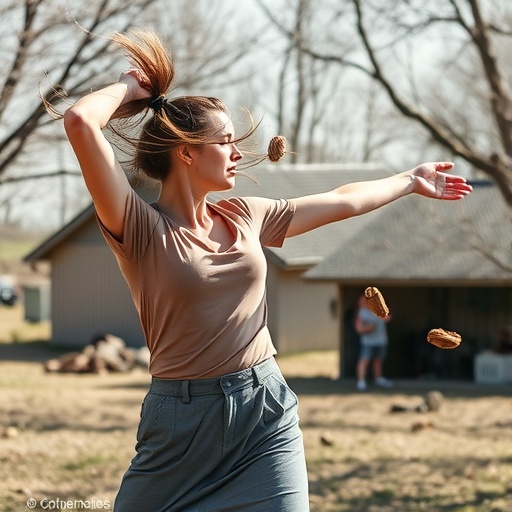In a groundbreaking and provocative exploration, Anne Fausto-Sterling presents a fresh perspective in her latest article titled “Throwing Like a Girl: A Critique of Past Approaches and an Illustrated Proposal for a Path Forward.” This work, set to appear in the 2025 issue of Biology of Sex Differences, challenges the normative assumptions surrounding gendered physical performance, particularly in the context of throwing—a seemingly mundane yet culturally loaded act. Fausto-Sterling, a distinguished biologist and gender studies scholar, aims to scrutinize the biases that have historically shaped our understanding of sex differences in sports and physical activities.
Throwing, often considered a fundamental aspect of athleticism, has been an area of interest in the study of gender differences. Fausto-Sterling notes that historically, research surrounding physical performance has been riddled with stereotypes that promote a binary view of gender. This perspective posits that men are naturally predisposed to superior strength and coordination, while women are relegated to notions of fragility and ineffectiveness in sports. Such views have not only influenced scientific discourse but have also permeated societal beliefs about gender capabilities.
In her article, Fausto-Sterling meticulously critiques traditional methodologies employed in past research on gender and physical performance. She argues that these approaches often employ a narrow lens, failing to account for the ecological and social factors that shape how individuals engage in physical activities. By exposing the methodological flaws of these studies, Fausto-Sterling asserts that conclusions drawn from them are frequently biased, reinforcing stereotypes rather than illuminating the complexities of human performance across sexes.
Furthermore, Fausto-Sterling emphasizes the importance of an interdisciplinary approach to understanding physical performance. By integrating insights from biology, anthropology, sociology, and psychology, she advocates for a holistic view that considers not only physiological factors but also social contexts and individual experiences. This paradigm shift could pave the way for a more nuanced understanding of how gender influences performance in sports, leading to more equitable practices and policies.
One novel aspect of Fausto-Sterling’s proposal is her call for the incorporation of visual illustrations in research to enhance comprehension and engagement among audiences. By utilizing detailed visual representations of gendered throwing techniques and the underlying biomechanics, her work strives to make the science accessible and relatable. This emphasis on illustration serves a dual purpose: making complex concepts more digestible while also countering traditional narratives that often favor male performance.
Moreover, Fausto-Sterling touches on the societal implications of her research, connecting the dots between physical performance and broader issues of gender identity and representation in sports. The entrenched biases regarding throwing and other physical activities can lead to diminished opportunities for women and girls, perpetuating cycles of inequality. By challenging these misconceptions, her work aims to inspire a culture shift that celebrates athleticism across all genders without restrictive labels.
The paper also discusses the potential for educational interventions that promote equitable practices in sports. Fausto-Sterling envisions programs targeting young athletes, educators, and coaches that would encompass training on the fluidity of gender expression and the importance of inclusivity. Such initiatives can empower individuals to recognize and dismantle the stereotypes that inhibit performance and participation, fostering an environment where every athlete can thrive regardless of gender.
From a biological perspective, Fausto-Sterling’s research underscores the need for ongoing investigation into how various factors such as hormones, muscle physiology, and neuromuscular coordination impact throwing performance. She highlights that the existing literature often neglects the interplay between these biological elements and the social constructs surrounding gender. By focusing on the intricate layers of performance, she posits that a clearer picture of athletic potential is revealed—one that is not solely defined by gender binaries.
Ultimately, “Throwing Like a Girl” presents a compelling call to action for researchers, educators, and athletes alike. Fausto-Sterling’s proposed framework emphasizes the significance of re-examining long-held beliefs about gender and physicality. By advocating for a more equitable and informed approach to understanding performance, she invites a reevaluation of the narratives that have shaped perceptions of gender in sports over the years.
In conclusion, Anne Fausto-Sterling’s article is not merely an academic critique but a revolutionary call for rethinking how society perceives and values performance across all genders. By engaging with the complexities of gender identity, physical performance, and societal expectations, her work offers a path forward that champions inclusivity, equity, and a richer understanding of human potential. Through meticulous research and passionate advocacy, Fausto-Sterling is positioning this vital conversation at the forefront of discussions about gender in sports, promising to inspire future generations of athletes and scholars.
As her article proceeds to publication, it is poised to gain significant attention for its timely and essential content—a rallying cry for anyone invested in the realms of sports, gender studies, and human performance.
Subject of Research: Gender differences in physical performance, specifically in throwing.
Article Title: Throwing like a girl: a critique of past approaches and an illustrated proposal for a path forward.
Article References:
Fausto-Sterling, A. Throwing like a girl: a critique of past approaches and an illustrated proposal for a path forward.
Biol Sex Differ 16, 77 (2025). https://doi.org/10.1186/s13293-025-00759-8
Image Credits: AI Generated
DOI: 10.1186/s13293-025-00759-8
Keywords: Gender, physical performance, throwing, sports, inclusion, stereotypes, anatomy, social constructs, educational interventions, equity in athletics.




